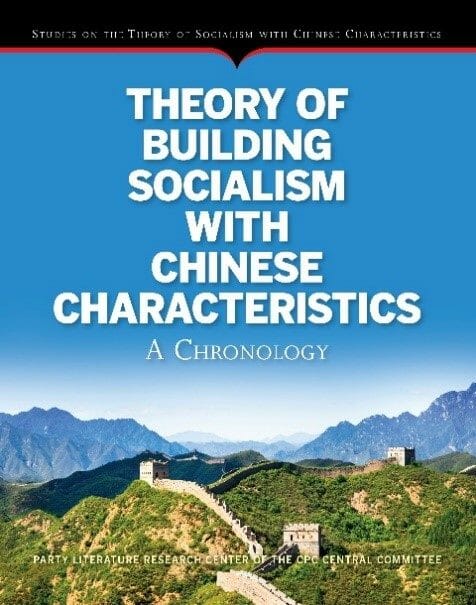By Kiang Yeow Yong, Development Editor, Gale Asia
Theory of Building Socialism with Chinese Characteristics: A Chronology is a Gale Asia title published in November 2015. Presented in the form of a detailed chronology of key events and people based on archival records – mainly excerpts from official documents, speeches, and talks – the book provides readers with a comprehensive overview of the arduous process of how the Chinese communists integrated Marxism with the concrete realities of China from 1978 to 2011, and established a theoretical framework around the theme of building socialism with unique Chinese characteristics.

Party Literature Research Center of the CPC Central Committee
Published By: Gale Asia
ISBN-10: 9814698148 ISBN-13: 9789814698146
As the in-house editor working on this title, I noticed an interesting tendency among the Chinese communist leaders, namely Deng Xiaoping, Jiang Zemin, and Hu Jintao, to use “North–South”-related terms like “North–South divide”, “North–South dialogue”, “North–South relations”, “North–South issue”, and “North–South problem” whenever they talked about international affairs.
The words “North” and “South” in the speeches of Chinese leaders are not simply geographical terms, but are terms borrowed from international politics. “North” and “South”, when used in the global political and economic context, are, in fact, alternative designations for “developed” and “developing” countries. The World History Encyclopedia, which is available in Gale Virtual Reference Library, offers a clear and explicit definition of the “North” and the “South”:
The conceptualization of what has been termed the North-South paradigm (or development gap) is characterized by the social, economic, and political division that exists between the wealthy developed countries collectively known as the North and the poorer developing countries or least-developed countries (LDCs) known as the South (Latin America, Africa, and Asia). Although most nations comprising the North are located in the Northern Hemisphere (Europe, Russia, Canada, and the United States), the divide is not simply defined by geography, as wealthy countries in the Southern Hemisphere such as New Zealand and Australia are also included as part of the North.[1]
The concept of “South–South cooperation” was first proposed to promote trade collaboration, economic alliance, and cooperative relations (in particular the exchange of resources, technology, and knowledge) between developing countries, widely regarded as the underdeveloped regions of the world. The aim was to decrease their dependence on the financial aid and assistance programs offered by developed countries, and which consequently effected a shift in the international balance of power (for an overview of the historical background and dynamics behind the formation of South–South cooperation, see “Introduction: South–South Cooperation and the Global Economic (R)evolution” in The Rise of the Global South: Philosophical, Geopolitical and Economic Trends of the 21st Century, Gale Virtual Reference Library).
Therefore, the perspectives of the Chinese communist leaders are actually consistent with how international statesmen, policymakers, and academics have generally viewed the polarized world in the postwar decades. This observation is vividly illustrated in the following excerpts of speeches or talks by Deng Xiaoping, the paramount leader of China in the post-Mao era and the “chief engineer” of the nation’s economic Reform and Opening up program.
In his meeting with a delegation from the Indian Council for Social Sciences Research, Deng Xiaoping talked about North–South relations and South–South cooperation:
We are very pleased that Third World countries have put forward the question of South–South cooperation. Of course, the question of relationships between the South and the North must also be resolved. With the Third World so heavily in debt, how will its people be able to survive? The rich countries are getting richer and the poor ones are getting poorer. Solving this problem is a major and obviously difficult international task. It is not enough for the Third World to place its hopes on a change in relationship between the South and the North. There must also be South–South cooperation. In one way or another, a certain range of problems can be solved through such cooperation. During recent years, the Third World has developed to some extent. Every country has good things to exchange with other countries and can cooperate with them. If we want to change the international economic order, we must, above all, settle the question of the relationship between the South and the North, but at the same time we have to find new ways to increase South–South cooperation.
(October 22, 1982 entry, 107)
Deng attributed the development gap between the “North” and the “South” to the former’s “exploitation and plunder” of the latter. Therefore, to solve “the North–South issue, the North is supposed to undertake more responsibilities.” (May 17, 1984 entry, 141-142)
Deng also made connections between China’s Opening-up and Reform program and South-South cooperation as well as the goal of narrowing the gap between developed and developing countries. This can be seen clearly in his talk when meeting with Mohamed Mzali, Prime Minister of Tunisia:
At the Third Plenary Session of the 11th CPC Central Committee, the policy of opening to the outside world was adopted. At that time, generally speaking, only developed countries were taken into consideration. In the past three years, new content has been added to this policy. One important part is South–South cooperation, that is, cooperation with Third World countries. The world at present is confronted with the problem of North–South relations. If not well resolved, it will prevent the progress of developed countries. Where are the markets for developed countries whose population accounts for less than 25 percent of the world’s population? If the other 75 percent remain poor, the markets will not exist. The problem of North–South relationships was raised before, but we still cannot see the glimmering of a solution. Developed countries are rich but not generous. The development of South–South cooperation may promote the settlement of the North–South problem.
(Oct 23, 1984 entry, 157)
It is worth noting that the Chinese communist leaders seemed to have reached a consensus on the “North–South” problem, for the succeeding presidents of China, Jiang Zemin and Hu Jintao, also echoed similar views on the issue of the “North” and “South” from time to time. For instance, when delivering his speech at the panel discussion of the U.N. Millennium Summit held at the United Nations Headquarters in New York in 2000, Jiang Zemin said: “All countries, whether in the South or North, whether big or small, should be the beneficiaries of economic globalization. What we need is economic globalization with equality for all countries. The prosperity of a minority of countries shouldn’t and can’t be built on the foundation of impoverishment of a great many countries in the South.” (Sep 7, 2000 entry, 563) Similarly, Hu Jintao, when addressing the attendees of the Third G20 Financial Summit in 2009, pointed out: “The issue of global economic imbalances has drawn close attention from the international community. …The root cause, however, is the yawning development gap between the North and the South. Only with real development of the vast developing world can there be solid global economic recovery and sustainable world economic growth.” (Sep 25, 2009 entry, 800) Also, in his speech at the Third Meeting of Leaders of the BRICS Countries in 2011, Hu shared that “the biggest imbalance in the world economy is the development imbalance between the North and the South, and the most fundamental problem in the world economy is the inadequate development of undeveloped and developing countries” (April 14, 2011 entry, 836).
Theory of Building Socialism with Chinese Characteristics: A Chronology offers a convenient source and important reference material for any English-reader who is interested in understanding the official history and political ideology of contemporary China. It is a title in the series “Studies on the Theory of Socialism with Chinese Characteristics”. You can find more information about the series by clicking on this link to Gale’s online catalog.
[1] “Development Gap—The North and the South.” World History Encyclopedia, edited by Alfred J. Andrea and Carolyn Neel, vol. 20: Era 9: Promises and Paradoxes, 1945-Present, ABC-CLIO, 2011, pp. 445-446. Gale Virtual Reference Library


